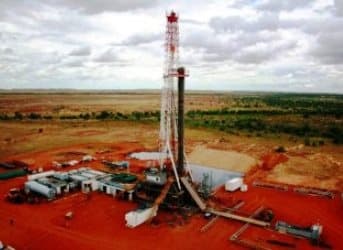South Africa, black Africa’s largest economy, has an Achilles heel – energy.
Accordingly, any and all energy sources, from coal to renewables, are on the table.
South Africa has only small deposits of conventional oil and natural gas and accordingly uses its vast coal deposits for the majority of its energy needs, particularly in generating electricity. Most of South Africas oil imports are used primarily in the country’s transportation sector and imported from the Middle Eastern and West African producers before being locally refined.
South Africa also has a highly developed synthetic fuels industry, producing gasoline and diesel fuels from coal and natural gas. The synthetic fuels industry accounts for nearly all of the nation's domestically produced petroleum since crude oil production is trivial.
Two years ago South Africa’s proven oil reserves were estimated at a paltry 15 million barrels, contained in the offshore Bredasdorp basin and off South Africa’s western coast near the country’s border with Namibia. While South Africa currently has no significant crude oil production it presently produces slightly over 180,000 barrels per day of non-conventional, synthetic liquids processed from coal and natural gas.
Related article: Has the Shale Bubble Already Burst?
Given that South African oil consumption is estimated to be slightly over 550,000 bpd, beyond the indigenous synthetic fuel production, Pretoria imports approximately 370,000 bpd, roughly 67 percent of the country’s consumption, primarily from OPEC countries, chiefly Iran (29 percent, until international sanctions began to bite), Saudi Arabia (24 percent), Nigeria (19 percent) and Angola (18 percent).
Scrambling to keep the lights on and the economy humming, Pretoria has decided to pursue a multifaceted conservative and progressive energy policy.
On the conservative side, South African Minister of Trade and Industry Rob Davies announced that the cabinet intends to push ahead with building Coal 3, another thermal coal-fired power station. Two other major thermal coal stations, Medupi and Kusile, are also under construction. Davies said at a post-Cabinet briefing that once Eskom’s Medupi, Kusile and third thermal power plant projects are complete in 2018, they would add a combined 9,600 megawatts to the national grid.
These commitments come despite Pretoria debating introducing a carbon tax to reduce carbon emissions and a commitment by South Africa at the COP17 conference to reduce its carbon emissions by 34 percent by 2020.
Why the schizophrenia in government policies?
Economics.
South African state-owned electricity public utility Eskom, the largest producer of electricity in Africa, among the world’s top seven utilities in terms of generation capacity and among the top nine in terms of sales, in the past five years has increased electricity prices 300%, and earlier this year given government approval to increase prices by 8 percent annually for the next five years. Eskom has been struggling to meet electricity demand since rolling blackouts hit South Africa in 2008, costing the economy billions in lost production and economic growth. Eskom CEO Brian Dames has repeatedly stressed that his company needs to plan for the construction of new power stations now if the nation is to avoid further power shortages, because Eskom needs to replace its aging generating fleet, as its existing power stations are on average 30 years old.
Related article: Is Shale Gas Excitement in Eastern Europe Unwarranted?
But South Africa is not only looking to coal for its energy salvation, as the country is now considering hydraulic fracturing. Earlier this month Davies said that the government was finalizing the process of authorizing shale gas exploration in a “responsible” and “environmentally friendly” manner. In 2012 Pretoria lifted an interim moratorium on shale gas exploration, but has not yet licensed any energy company to start exploration, leaving Royal Dutch Shell awaiting a response to its application to explore for shale gas in the Karoo Basin, which the U.S. Energy Information Administration estimates could contain up to 485 trillion cubic feet of technically recoverable shale gas resources.
The upside of shale natural gas is that burning it contains fewer carbon emissions than either coal or natural gas. Accordingly, given South Africa’s energy deficits, the Karoo Basin would seem to be a done deal in the making, with the only question being how much Pretoria might insist that the exploration be done in a “responsible” and “environmentally friendly” manner.
Anything to keep the lights on.
By. John C.K. Daly of Oilprice.com



















"The upside of shale natural gas is that burning it contains fewer carbon emissions than either coal or natural gas."
How does burning shale natural gas emit less CO2 than burning conventional natural gas?
SA has a lot of unused wind resources. Given how fast Texas and Kansas have been able to build out their wind resources this seems like a quick early fix, supplemented by localized 3MWH sized vanadium flow battery storage systems to even out the energy available to the grid. The batteries can also serve to store off peak energy at night for use later in the day.